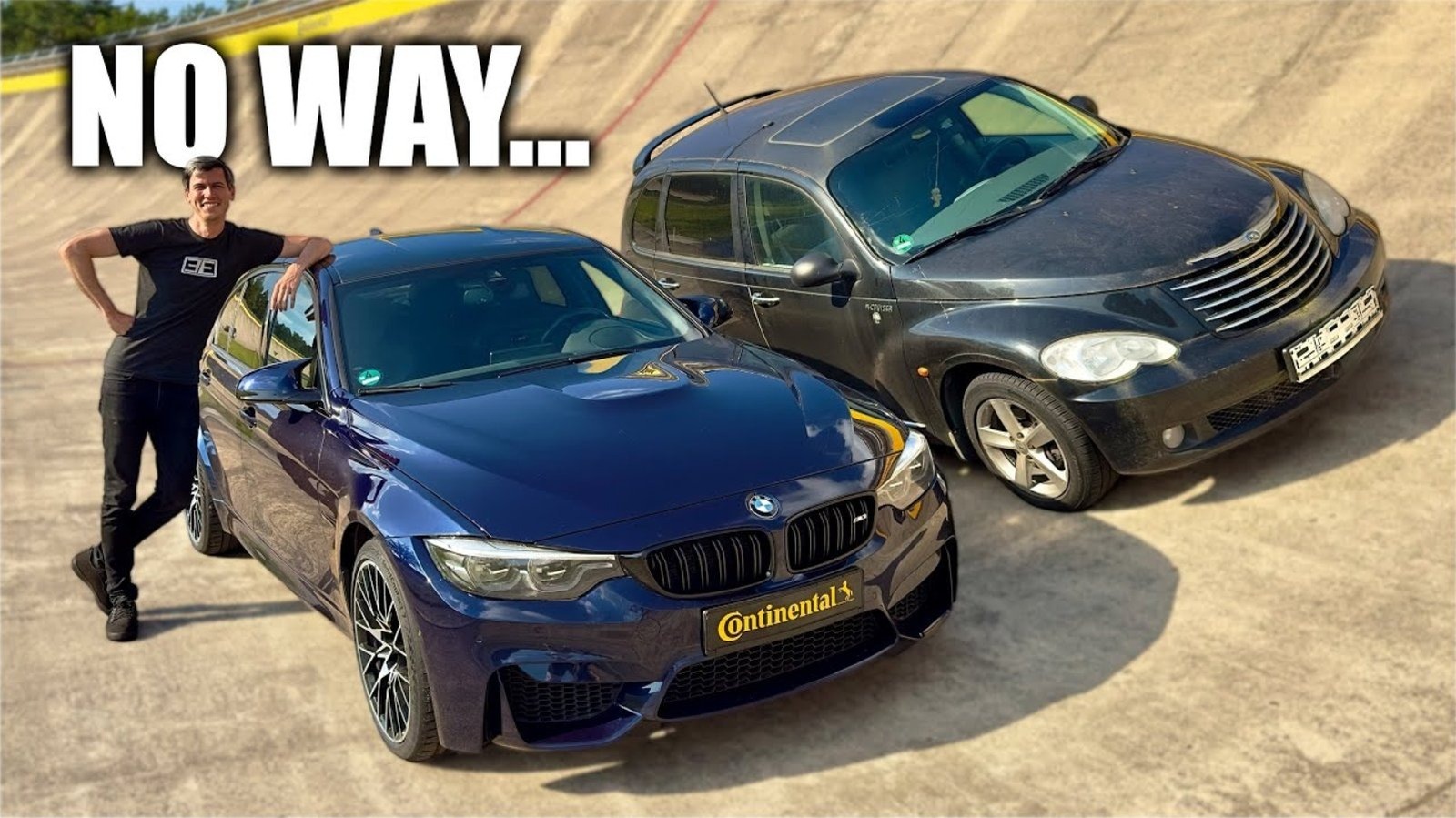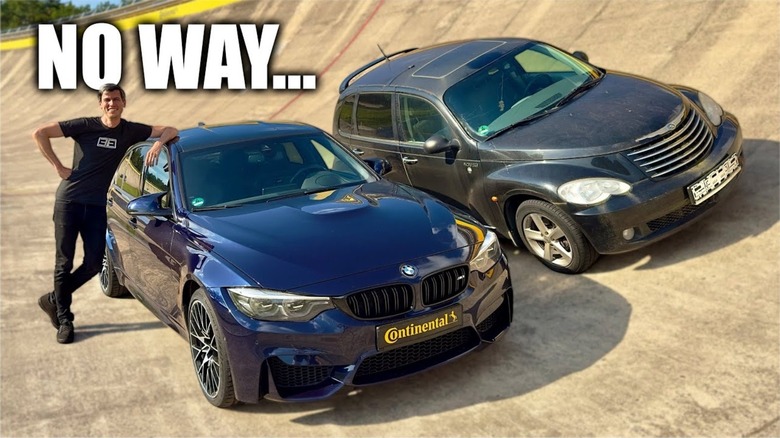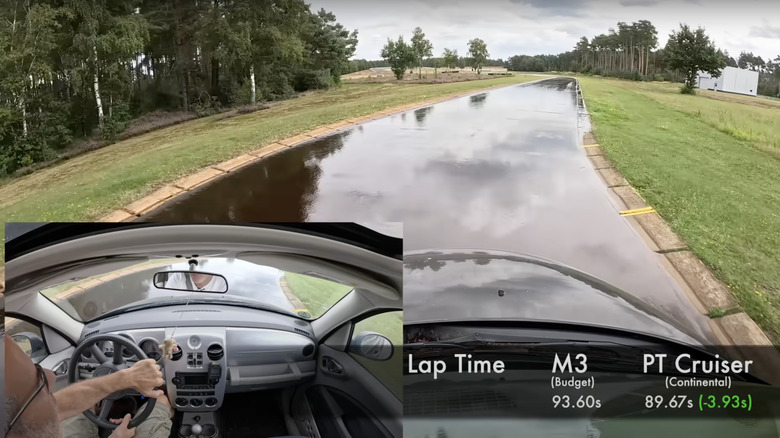Tires are important. You know that. I know that. We all know that. At the same time, though, the big-name brands charge a heck of a lot of money for tires. If I wanted to put a set of Continental ExtremeContact Sport 02s on my E39’s 17-inch wheels, Tire Rack says that would cost a whopping $911.96. Just for tires. Meanwhile, some company I’ve never heard of before will happily sell me a set of ultra-high-performance all-seasons for a mere $412.88. With a cost difference like that, you can see why it’s tempting to cheap out. Not all new tires are created equal, though, and what you save in the short term may end up costing you in the long run.
To highlight just how extreme the difference can be between quality tires and cheap alternatives, our friend Jason Fenske of Engineering Explained fame recently took a Chrysler PT Cruiser to a track to race against a BMW M3. And it wasn’t some Hellcat-swapped PT Cruiser with a track-tuned suspension and rear-wheel drive, either. In fact, it was a poorly kept diesel PT Cruiser, although it did have a manual transmission. The BMW, on the other hand, was an F80 M3 Competition that was purpose-built with track driving in mind. And while you could throw the M3 on the cheapest tires that would fit, while giving the PT Cruiser the stickiest street tires available, they tried to make things a little more fair by putting the PT Cruiser on a set of premium all-season touring tires and using budget high-performance tires on the M3.
Diesel PT Cruiser vs. BMW M3 Competition
Sadly, this comparison doesn’t include every possible test that you could run on these two cars and instead focuses on wet handling, wet braking and dry braking. Around the 1.14-mile test track, the M3 posted a best time of 93.60 seconds. Meanwhile, the PT Cruiser’s best time was 89.67 seconds, nearly four full seconds faster than the BMW. A BMW that had three times the horsepower when these cars were new. Sure, the PT Cruiser’s diesel engine is relatively torquey but it never had “destroy an M3” levels of torque. Not even close. The difference really is just good tires.
As for the wet braking test, not only did the BMW have better brakes, it also had the advantage of anti-lock braking technology that was 15 years newer than what Chrysler gave the PT Cruiser. Yet, while its average stopping distance was 107.25 feet, the much older and objectively worse PT Cruiser only needed an average of 101.02 feet to come to a stop. That said, in the dry, the M3 on budget tires did pull out a win. With a higher starting speed than in the wet braking test, the M3 needed an average of 127.03 feet to stop compared to the PT Cruiser’s 136.91 feet. Give the PT Cruiser a modern ABS system, though, and Fenske theorized it would have been able to nearly close the gap.
To see what the M3 could actually do on the right tires, they then put it on a set of premium ultra-high-performance tires. Dry braking distance dropped by 18.31 feet, while wet braking improved by 17.59 feet, and it lapped the wet track with a time that was 14.50 seconds faster. So yeah, good tires matter.
But good tires are expensive
Even though we already knew expensive tires were better than cheap tires, seeing the two compared like this really does underscore the fact that tires really are the most important performance mod. You can tune an engine to within an inch of its life and buy the most expensive suspension components imaginable, but if you cheap out on tires, you may still lose to a driver with a worse car and better tires. And while not everyone competes in autocross or takes their car to the track, those same tires will also perform better in inclement weather and during emergency maneuvers, where the consequences of losing control or not stopping fast enough could easily cost you more than the few hundred dollars you saved on tires.
The other factor to consider here is longevity. While a less-expensive tire may cost less money today, budget tires don’t typically last anywhere near as long as the ones that cost $200+. If you have to buy a new set after 30,000 miles, you aren’t saving any money over tires that would last 80,000 miles or more. You’ll also be lucky to get a warranty on the budget tires that covers more than a few miles, if you even get one at all.
The brand I’d never heard of that I mentioned earlier? All they guarantee is even wear for the first 2/32″ and a six-year guarantee against defects. Meanwhile, the Continentals matched that and also offered a 30,000-mile warranty, as well as a one-year road-hazard warranty and three years of coverage for flats. Those aren’t even meant to be long-lasting tires, either. The Continentals Engineering Explained used on the PT Cruiser came with an 80,000-mile warranty, and Michelin Defender 2s are warrantied to last 100,000 miles. So while it may hurt to spend so much money on tires, as long as you have the money, you’re basically guaranteed to save money in the long run.




